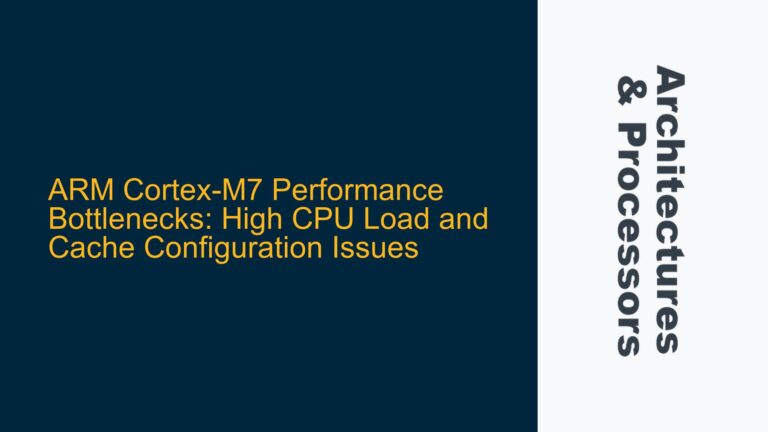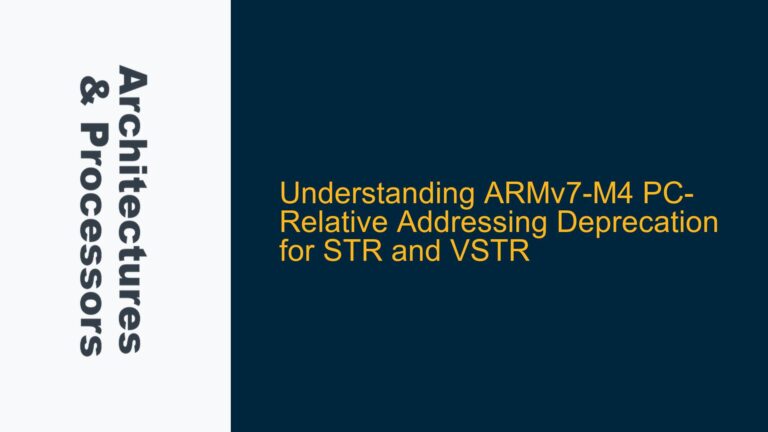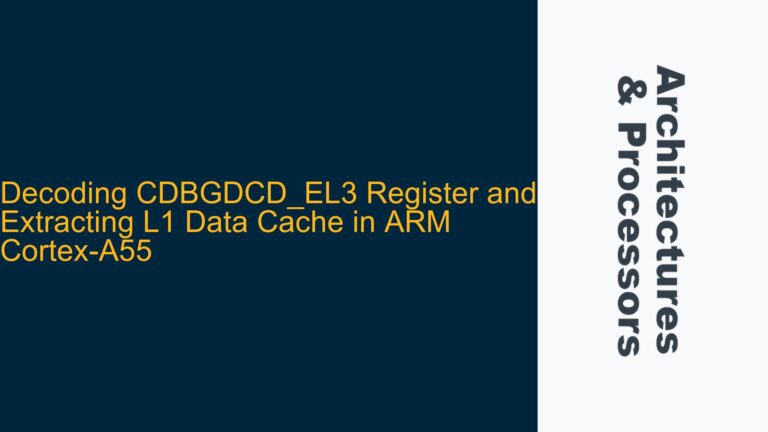ARM Cortex-A53 Cache Coherency Breakdown During Warm Start
The issue described revolves around the ARM Cortex-A53 cores experiencing cache coherency problems during a warm start sequence, specifically when transitioning between 64-bit and 32-bit execution modes. In a cold start scenario, all four A53 cores execute bare metal code in 64-bit mode before jumping to a 32-bit kernel. During this transition, the cores share a global variable to check their status by incrementing a counter. In the cold start case, all cores can see updates to the global variable, indicating proper cache coherency. However, during a warm start, where the cores are put into a power-on reset state and resume execution in 64-bit mode before transitioning back to 32-bit mode, the cores fail to observe updates to the same global variable made by other cores. This suggests a breakdown in cache coherency during the warm start process.
The problem is particularly critical because it highlights a discrepancy between the cold and warm start behaviors, which should ideally be consistent. The Cortex-A53 processor, being part of the ARMv8-A architecture, relies heavily on cache coherency mechanisms to ensure that all cores see a consistent view of memory. The issue manifests specifically after the warm reset, where the global variable’s updates are not visible across cores, indicating that the cache coherency protocol is not functioning as expected.
This issue is further complicated by the mixed-mode execution (64-bit to 32-bit transition), which introduces additional layers of complexity in terms of memory addressing, cache management, and coherency protocols. The Cortex-A53 cores must maintain cache coherency across both execution modes, and any misconfiguration or oversight in the cache management during the warm start sequence can lead to the observed behavior.
Cache Coherency Protocol Misconfiguration and Warm Reset Initialization
The root cause of the cache coherency issue during warm start can be attributed to several potential factors, primarily centered around the cache coherency protocol and its initialization during the warm reset sequence. One of the key aspects to consider is whether the cache coherency management is properly initialized after the warm reset. The Cortex-A53 cores rely on the ARMv8-A cache coherency protocol, which includes mechanisms such as the Cache Coherency Unit (CCU) and the ACE (AXI Coherency Extensions) to ensure that all cores see a consistent view of memory.
During a warm reset, the state of the caches and the coherency protocol may not be automatically reset to a known state. If the cache coherency management is not explicitly re-initialized after the warm reset, the cores may continue to use stale cache entries or coherency states from before the reset. This can lead to the observed behavior where updates to the global variable are not visible across cores.
Another potential cause is the handling of the global variable in mixed-mode execution. When transitioning from 64-bit to 32-bit mode, the memory addressing and cache management mechanisms may behave differently. In 64-bit mode, the Cortex-A53 cores use 64-bit virtual addresses, while in 32-bit mode, they use 32-bit virtual addresses. If the cache coherency protocol is not properly configured to handle this transition, it may result in cache incoherency, where updates to the global variable in 32-bit mode are not properly propagated to other cores.
Additionally, the warm reset sequence itself may not be properly handling the cache invalidation and data synchronization barriers. The ARMv8-A architecture provides specific instructions for cache management, such as Data Cache Clean and Invalidate (DC CIVAC) and Data Synchronization Barrier (DSB), which are essential for ensuring cache coherency. If these instructions are not used correctly during the warm reset sequence, the caches may contain stale data, leading to the observed coherency issues.
Implementing Cache Coherency Management and Data Synchronization Barriers
To resolve the cache coherency issue during warm start, a comprehensive approach to cache management and data synchronization must be implemented. The first step is to ensure that the cache coherency management is properly initialized after the warm reset. This involves explicitly re-initializing the Cache Coherency Unit (CCU) and ensuring that the ACE (AXI Coherency Extensions) are properly configured. This can be done by writing to the appropriate system registers and ensuring that the cache coherency protocol is in a known state before resuming execution.
Next, the handling of the global variable in mixed-mode execution must be carefully managed. When transitioning from 64-bit to 32-bit mode, it is essential to ensure that the cache coherency protocol is aware of the change in memory addressing. This can be achieved by explicitly invalidating the cache entries associated with the global variable and ensuring that the cache coherency protocol is properly configured to handle 32-bit addresses. This may involve using the Data Cache Clean and Invalidate (DC CIVAC) instruction to ensure that the cache entries are properly synchronized across all cores.
In addition to cache management, the use of data synchronization barriers is critical to ensuring cache coherency. The ARMv8-A architecture provides several synchronization instructions, such as the Data Synchronization Barrier (DSB) and the Instruction Synchronization Barrier (ISB), which can be used to ensure that all memory operations are properly synchronized across all cores. These instructions should be used strategically during the warm reset sequence to ensure that all cache operations are properly completed before resuming execution.
Finally, it is important to verify that the cache coherency is maintained in 64-bit mode before transitioning to 32-bit mode. This can be done by performing a series of tests to ensure that all cores can see updates to the global variable in 64-bit mode. If the cache coherency is not maintained in 64-bit mode, it is likely that the issue lies in the cache coherency management during the warm reset sequence, and further investigation is required.
In conclusion, the cache coherency issue during warm start in the ARM Cortex-A53 cores can be resolved by properly initializing the cache coherency management, carefully handling the global variable in mixed-mode execution, and using data synchronization barriers to ensure that all memory operations are properly synchronized. By following these steps, the cache coherency can be maintained, and the issue can be resolved.






